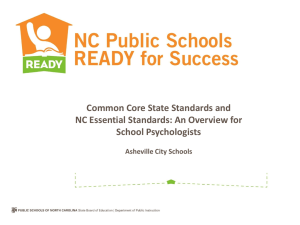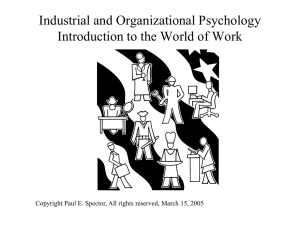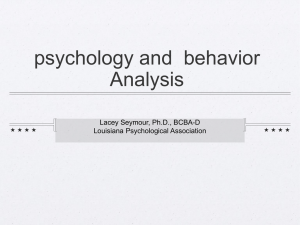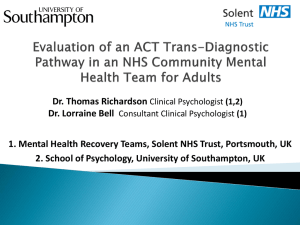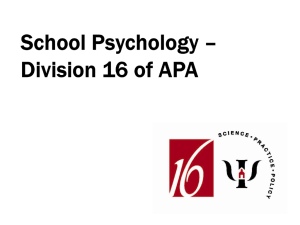The Role of the School Psychologist in Transition Planning: A
advertisement
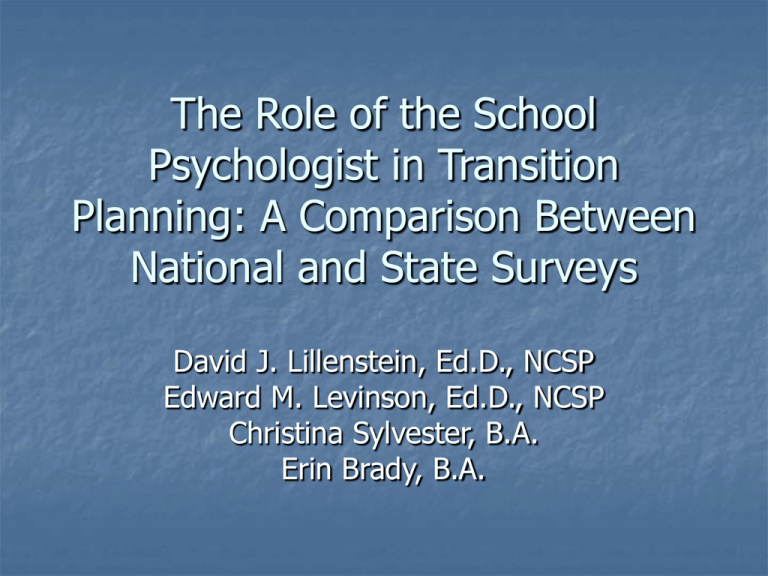
The Role of the School Psychologist in Transition Planning: A Comparison Between National and State Surveys David J. Lillenstein, Ed.D., NCSP Edward M. Levinson, Ed.D., NCSP Christina Sylvester, B.A. Erin Brady, B.A. As compared to people without disabilities, people with disabilities: experience increased unemployment rates (National Council on Disability, 2000) are more likely to live in poverty (National Council on Disability, 2000) have a higher school dropout rate (National Center for Learning Disabilities, 2002; U.S. Department of Education 2001) But things are improving… The National Longitudinal Transition Study (1985-1993) and the National Longitudinal Transition Study-2 (2000-2009) track the experiences of 13 to 16 year olds throughout high school Information is collected through telephone interviews, school surveys, student assessments, and transcripts data from NLTS-2 show an improvement NLTS vs. NLTS-2 NLTS (1987) 55% of youth with disabilities completed high school NLTS-2 (2003) 72% of youth with disabilities completed high school significant increase in the percentage of students with mental retardation, learning disabilities, and emotional disturbances, who completed school Why have things improved? One reason could be transition planning Transition planning helps students adapt to life after secondary school in the areas of: Employment Independent living Post-secondary education Transition Planning Transition Plans became a required part of the Individualized Education Program in 1990 When IDEIA was signed into law, transition planning became a requirement by age 16, rather than 14, and is to be more resultsfocused Transition Planning Transition planning is mandated under IDEIA But… it does not specify who is responsible school districts often use special education teachers Transition Planning Transition planning should use a team approach (deFur, 1999) each member acts as a representative expands the range of expertise Transition Planning The team should be representative of many disciplines (Wehman et al, 1987) better able to address the needs of individuals (Krieg, Brown, & Ballard, 1995) participation of therapy-related service providers declines as students enter secondary education (USDOE, 1995) School Psychologists and Transition studies have found that more than 90% of practicing school psychologists believed they should be more involved in transition activities (Shepard, 1982) a more recent national survey of school psychologists found that less than 1% of time was spent in vocational assessment (Carey, 1995) School Psychologists and Transition School psychologists possess many transitionrelated skills in the four NASP categories consultation psychological and psycho-educational assessment direct services program planning and evaluation Consultation in-service workshops instructional consultant Psychological and Psychoeducational Assessment establish and test interventions monitor progress evaluate outcomes (Reschly & Ysseldyke, 1995) Direct Services social skills training programs behavior management programs meet with parents and students following an assessment Program Planning and Evaluation planning and implementation of program evaluation assess the effectiveness of interventions assess extent to which students are progressing Purpose of Staab Study (1996) National survey of school psychologists involvement in transition importance of involvement in transition barriers to involvement in transition Purpose of this Study involvement of school psychologists in transition planning in Pennsylvania importance of involvement barriers impacting involvement comparison between national (Staab, 1996) and Pennsylvania samples Methods adaptation of Staab’s (1996) survey demographic information tasks from each of the NASP categories tasks list of potential barriers Methods survey was sent to 450 school psychologists follow-up was sent after 14 and 30 days 150 school psychologists returned the survey Demographic Information Study 150 school psychologists 38.4% male 61.6% female mean number of years of experience is 16.8 mean age - 44.6 years Pennsylvania 950 school psychologists (PDE, 1999) 38% male 62% female mean number of years of experience is 15.6 Demographic information cont. 8.1% urban 48.8% suburban 43.1% rural 35.8% Western Pennsylvania 39% Central Pennsylvania 25.2% Eastern Pennsylvania Preparation to participate Transition Planning National (Staab, 1996) Pennsylvania Needed more information - 50% Adequately Prepared - 33% Not prepared - 9.6% Needed more information - 54.4% Adequately prepared - 25.6% Well prepared - 10.4% Training 53.6% received training through in-service workshops .8 % received their training through a graduate program in “transition” Involvement vs. Importance Independent samples t-tests compared involvement and perceived importance Bonferroni procedure was used to maintain a family wise error rate of .05 (Rosenthal & Rosnow, 1991, p. 329) Importance was greater than involvement for all tasks (p < .0001) Involvement Independent samples t-tests compared national and state samples on involvement Bonferroni procedure was used to maintain a family wise error rate of .05 (Rosenthal & Rosnow, 1991, p. 329) Significant differences were identified in each of the four categories Consultation similar level of involvement between national and state sample on 70% of tasks national sample reported greater involvement in: consultation to develop self-advocacy/selfdetermination coordination of assessments to avoid duplication participation in local Transition Council Psychological and Psychoeducational Assessment similar level of involvement between national and state sample on 67% of tasks national sample reported greater involvement in: interviewing students on interests/preferences for future planning explaining test results to students to understand strengths/needs Direct Services similar level of involvement between national and state sample on 67% of tasks national sample reported greater involvement in: providing student training on interpersonal/social skills identifying “at-risk” students and initiating transition planning Program Planning and Evaluation similar level of involvement between national and state sample on 89% of tasks national sample reported greater involvement in: developing social skills training programs for students Importance Independent samples t-tests compared national and state samples on importance Bonferroni procedure was used to maintain a family wise error rate of .05 (Rosenthal & Rosnow, 1991, p. 329) Significant differences were identified in the Consultation and Direct Services categories Consultation similar level of importance between national and state sample on 90% of tasks national sample reported greater importance of: providing student training on interpersonal/social skills Direct Services similar level of importance between national and state sample on 57% of tasks national sample reported greater importance of: attending secondary IEPs where transition is discussed providing student training on interpersonal/social skills Current Involvement vs. Perceived Importance of Involvement differences between perceived importance and current involvement in transition activities were compared for the two samples for each item, the involvement rating was subtracted from the importance rating and these scores were compared between samples Bonferroni procedure was used to maintain a family wise error rate of .05 (Rosenthal & Rosnow, 1991, p. 329) Consultation similar level between national and state samples on 90% of tasks larger difference for state than national for: consulting to develop self-advocacy/selfdetermination Psychological and Psychoeducational Assessment similar level between national and state sample on 83% of tasks larger difference for state than national for: explaining test results to students to understand strengths/needs Direct Services similar level between national and state sample on 71% of tasks larger difference for state than national for: attending secondary IEPs where transition is discussed identifying “at-risk” students and initiating transition planning Barriers to transition involvement a z-test compared the responses from participants in the national and state samples percentage of school psychologists listing each barrier was computed percentages were compared between groups Barriers no significant differences between the two samples on the ratings of 63% of the barriers transition is not part of job description lack of interest in transition activities lack of training in transition high caseload number of buildings served Barriers significant difference between samples for the barriers: referral backlog 71.2 % 56.8 % little secondary work PA National PA National 17.6 % 40.6% role restrictions PA National 36.8 % 58.6 % Discussion many similarities in the perceptions of the role of school psychologists in transition planning similar involvement, perceived importance of involvement, and differences between involvement and importance both indicated the need for additional training Differences in Involvement The school psychologists in the national sample reported greater involvement than the state sample on several tasks: consulting to develop self-advocacy/self-determination coordinating assessments to avoid duplication participating in the local transition council interviewing students on interests/preferences for future planning explaining test results to students to understand strengths/needs providing student training on interpersonal/social skills identifying “at-risk” students and initiating transition planning developing social skills training programs for students Importance vs. Involvement both samples reported greater importance than involvement this is consistent with existing literature (Levinson, 1990; Reschly & Wilson, 1995; Staab, 1996) Differences in Importance National sample reported greater importance than state sample on several tasks participating in the local Transition Council attending secondary IEPs where transition is discussed providing student training on interpersonal/social skills identifying “at-risk” students Differences between Involvement and Importance State sample reported larger differences than national sample on several tasks consulting to develop self-advocacy/self-determination explaining test results to students attending IEPs where transition is discussed identifying “at-risk” students Differences between Involvement and Importance cont. differences on the tasks, consulting to develop self-advocacy/self-determination, and explaining test results to students, are attributable to greater involvement in these tasks by school psychologists in the national sample Differences between Involvement and Importance cont. differences between groups on attending IEPs where transition is discussed, and identifying “at-risk” students, are attributable to differences in involvement Barriers A larger percentage of participants in the national study perceived “little secondary work” and “role restrictions” as barriers A larger percentage of participants in Pennsylvania reported “referral backlog” to be a barrier Reasons for Differences several factors may explain these differences 50% of national sample respondents worked at the secondary level 20% of the Pennsylvania respondents worked at the secondary level Reasons for Differences 89.6% of the Pennsylvania sample reported that “assessment” was their primary role previous studies have suggested that school psychologists nationally spend 50% of their time in “assessment-type” activities (Benson & Hughes, 1985; Goh et al., 1981; Gutkin & Conoley, 1990; Hutton et al., 1992; Reschly & Wilson, 1995) Reasons for Differences differences may also be attributable to the presence or absence of a "transition coordinator" Limitations of the PA Study response rate 28.3% of the surveys were returned survey structure 4-point Likert scale Implications results from national studies may not be indicative of trends in individual states school psychologists need more transitionrelated training Training programs and workshops Ulmer, 2004 Areas for Additional Research the role of the school psychologist in individual states further examination of barriers review the curriculum content of NASPaccredited programs as it relates to transition References Benson, A.J., & Hughes, J. (1985). Perceptions of role definition processes in school psychology: A national survey. School Psychology Review, 14, 64-74. Carey, K. (1995). A national study of the role and function of the school psychologist. Paper presented at the annual meeting of the National Association of School Psychologists, Chicago, IL. deFur, S. H. (1999). Special education, transition, and school-based services: Are they meant for each other? In DeFur, S. H., & Patton, J. R. (Eds.). (1999). Transition and school-based services: Interdisciplinary perspectives for enhancing the transition process. Austin, TX: Pro-ed. Goh, D.S., Teslow, C.J., & Fuller, G.B. (1981). The practice of psychological assessment among several psychologists. Professional Psychology, 12, 696-706. References Gutkin, T.B., & Conoley, J.C. (1990). Reconceptualizing school psychology from a service delivery perspective: Implications for practice, training, and research. Journal of School Psychology, 28, 203-223. Hutton, J.B., Dubes, R., & Muir, S. (1992). Assessment practices of school psychologists: Ten years later. School Psychology Review, 21(2), 271-284. Krieg, F. J., Brown, P., & Ballard, J. (1995). Transition: School to work. Bethesda, MD: National Association of School Psychologists. Levinson, E.M. (1990). Actual/desired role functioning, perceived control over role functioning, and job satisfaction among school psychologists. Psychology in the Schools, 27(1), 64-74. References National Center for Learning Disabilities. (2002). Students with learning disabilities: A national review. Retrieved August 6, 2004, from National Center for Learning Disabilities Web site: http://www.ncld.org/advocacy/pdf/NatlLDReview.pdf National Council on Disability. (2000). National disability policy: A progress, report, November 1, 1998-November 19, 1999. Washington, D. C.: Author. (ERIC Document Reproduction Service No. ED442240) Reschly, D.J., & Wilson, M.S. (1995). School psychology practitioners and faculty; 1986 to 1991-92. Trends in demographics, roles, satisfaction, and system reform. School Psychology Review, 24(1), 62-80. References Pennsylvania Department of Education- Bureau of Education (1999). Pennsylvania Guidelines for Secondary Transition for Students with Disabilities. Harrisburg, PA: Author. Reschly, D. J., & Ysseldyke, J. (1995). School psychology paradigm shift. In A. Thomas & J. Grimes (Eds.), Best practices in school psychology III, (pp. 17-32).Washington, DC: National Association of School Psychologists. Rosenthal, R., & Rosnow, R.L. (1991). Essentials of behavioral research: methods and data analysis. New York: McGraw-Hill. Shepard, J. W. (1982). Career development function of school psychologists. Doctoral dissertation, Virginia Polytechnic Institute and State University, Virginia. SRI International (2005). National Longitudinal Transition Study- 2 (NLTS2) Facts from NLTS2. References Staab, M. J. (1996). The role of the school psychologist in transition planning (Doctoral dissertation, University of Kansas, 1996). Dissertation Abstracts International, 58, 281. Ulmer, T. P. (2004). An investigation of the factors that influence the involvement of school psychologists in transition services (Doctoral dissertation, University of Northern Colorado, 2004). Dissertation Abstracts International, 65(7-B), 3731. U.S. Department of Education. (1995). To assure the free appropriate public education of all children with disabilities: Eighteenth annual report to Congress on the implementation of the Individuals with Disabilities Education Act. Washington, D. C.: Author. References U.S. Department of Education. (2001). Twenty-third annual report to Congress on the implementation of the individuals with Disabilities Education Act. Washington, DC: Author Wehman, P., Moon, M. S., Everson, J., Marchant, J., & Walker, R. (1987). Transition from school to work: New challenges for youth with severe disabilities. Baltimore: Paul H. Brookes. Contacts Dr. David J. Lillenstein, NCSP Director of Psychological Services Derry Township School District, Hershey, PA dlillenstein@hershey.k12.pa.us (717) 531-2277 x5436 Dr. Edward M. Levinson, NCSP Professor – Educational & School Psychology Indiana University of PA emlevins@iup.edu (724) 357-3786 Erin Brady Graduate Student – School Psychology IUP e.e.brady@iup.edu (724) 357-2316 Christina Sylvester Graduate Student – School Psychology IUP c.a.sylvester@iup.edu (724) 357-2316


